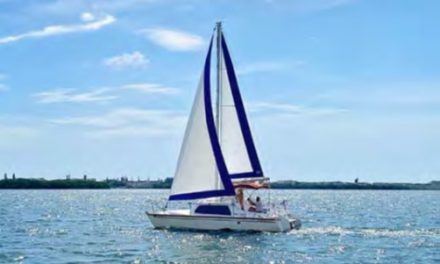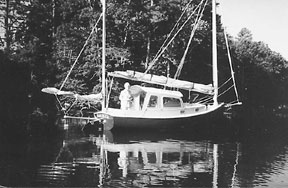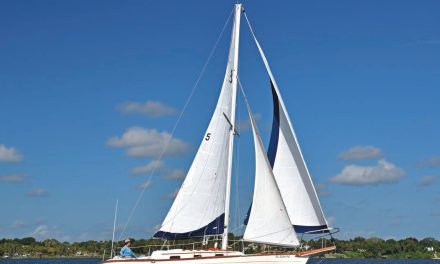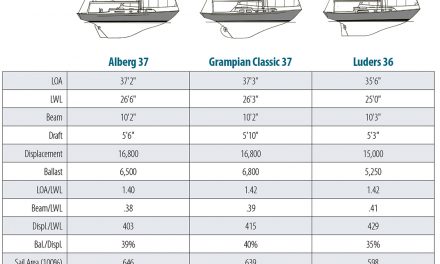One man, one woman, one J/32
Anatomy of a J/32
When we began looking for a boat, we had in mind something in the 30- to 35-foot range with a fractional rig that would sail well with a modest-sized jib. This was what first attracted our attention to the then newly introduced J/32. It has a 7/8 fractional rig with a relatively small J-dimension of 11.0 feet on an overall length of 32.4 feet. This means the mast is stepped relatively far forward and the mainsail provides most of the drive. Even with a 150 percent genoa, my wife, Mary Jeanne, can sheet home the jib in any breeze where it is reasonable to carry such a sail.
Sailing performance
I find this boat a delight to sail. It’s very responsive and easily handled by a retirement-aged couple. Our J/32 is relatively stiff, stays on her feet well, and exhibits excellent static and dynamic stability. Weather helm builds slowly as the wind increases and gives plenty of warning about the need to reduce sail.
This boat seems to have been carefully designed to be sailed by a single watch-stander, something I find essential for extended coastal cruising as a couple. The following features contribute to this:
- The boom-end sheeting and traveler controls for the main are easily handled from the helm.
- The primary winches can be reached and used with one hand still on the wheel.
- The halyards are brought aft to line clutches atop the coachroof.
- A responsive and powerful rudder allows one to quickly bear away from close-hauled, if necessary, without having to first ease the main. (I well remember a heavy-air night race in the Strait of Juan de Fuca aboard a 35-foot passagemaker where we could not bear away to round the weather mark until someone released the mainsheet from its winch.)
- The hydraulic backstay adjuster enables quick changes in mast bend to flatten the middle and upper mainsail as desired.
- Single-line reefing with a winch and line clutches at the edge of the coachroof make it possible to tuck two reefs into the main without leaving the cockpit.
- If further sail reductions are needed, the jib can be furled and the boat will sail nicely under main alone (like the J/30 reviewed in Good Old Boat in March 2007). With a second crew on deck, I generally choose to partially furl the jib first, which requires stepping outside the cockpit to move the jib fairlead cars forward.
Cruising attributes
Down below: The interior is surprisingly spacious for a 32-foot vessel and has a light, airy feel about it. The V-berth is generously sized with good stowage for extended cruises. The settees make comfortable sea berths, particularly with leecloths rigged. The starboard settee makes into a double, but this feature is best used by a pair who are good friends. We believe that the first owner of our boat chose wisely to forgo the quarter berth option and keep the starboard locker for gear stowage instead. We can still sleep five for a while without it.
The fold-up dining table contributes to the sense of a spacious, open main cabin. This choice would not work for a passagemaker where the table must be stout enough to hang on to, or fall against, at sea, but it does work well for coastal cruising. Eight opening portlights and three hatches assure good ventilation and the two dorades provide fresh air when under way in foul weather.
Crew coming below find easy access to the head compartment, which includes a convenient hanging space for wet gear. The galley is compact, but has sufficient space to serve its purpose. (We do plan to add a fold-out workshelf.)
Cockpit: The cockpit is very comfortable for two, and reasonable for four. The cockpit seat cushions are a welcome addition when cruising. The dodger and side curtains contribute to crew comfort, especially on a long travel day in foul weather. The dodger does not interfere with sail handling but can hinder forward visibility when docking for drivers less than 5 feet 10 inches tall.
Decks: The sidedecks are relatively wide and allow easy access forward. The foredeck provides plenty of room for handling ground tackle. We keep our primary anchor on the anchor roller and the secondary anchor (a 22-pound Bruce) in the anchor locker, which is quite spacious. Even with a windlass mounted on a shelf inside the locker, there is still room for two rodes: 400 feet of 1/2-inch Brait and 300 feet of 1/2-inch three-strand.
Tankage: Standard tankage for a J/32 is 50 gallons of potable water with an option for a second 50-gallon tank (plus six more in the hot water tank), 27 gallons of diesel for the 27-hp Yanmar 3GM30, and a 20-gallon holding tank. The propane locker holds one 10-pound aluminum tank to supply the Force 10 two-burner stove (with oven). These supplies give us all the range we need for our cruising style.
Racing impressions
We race our J/32 in club events and are reasonably competitive. However, some of the design features that make her a delight to cruise do compromise racing performance. Among them are the spacious interior and V-berth. This results in a fuller bow than a racing model and the half-angle of the bow is larger than that for the racing Js. Because of this and the higher displacement/length ratio, a J/32 does not point quite as well as a racing J/Boat or racing designs from other companies, and needs more wind to reach hull speed.
The relatively small foretriangle that first attracted our attention to the J/32 has a negative impact on downwind performance against most other boats in our fleet. Because of the small J-dimension and the fractional rig, the standard spinnaker is also relatively small. Once we turn downwind and set the chute, we are adding proportionally less sail area than the masthead rigs, which also all step their masts relatively farther aft. In theory, this is all taken into account in our PHRF rating. However, we find that the reduced horsepower downwind means that we must have an excellent upwind leg in order to save our time on the competitors.
Bottom line: Coastal cruising is our first love. This boat fits us very well and gives us the confidence to explore remote anchorages far up the coast. We can enjoy the camaraderie of club racing as well. But if racing were our primary passion, we would opt for one-design racing in one of the racing Js.
This is a supplement to the article printed in Good Old Boat magazine, July 2010.





